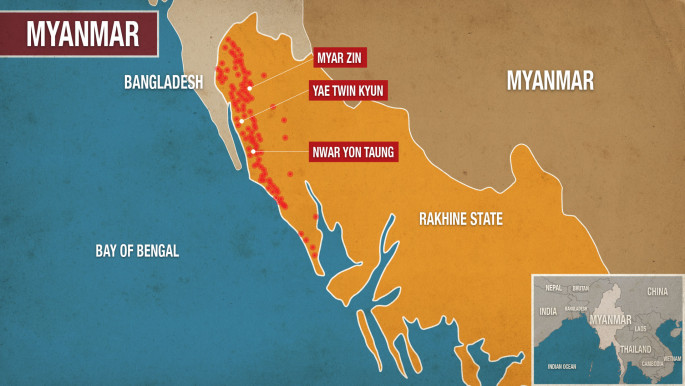Satellite images reveal mass destruction of Rohingya villages
More than 410,000 Rohingya Muslims have been driven from their homes in Buddhist-majority Myanmar since late August, when the army began a crackdown in Rakhine State.
Myanmar's military alleges that Rohingya militants attacked army bases in the region, but fleeing refugees have described a campaign of killings, shelling, looting and arson in Rohingya villages which has almost exclusively targeted civilians.
The detailed satellite imagery was taken on September 16 and analysis of the photos by Human Rights Watch reveals destruction on a scale much greater than previously thought, HRW said.
Tens of thousands of homes have been destroyed by deliberate arson attacks across the Maungdaw and Rathedaung Townships, with the maps showing more than 214 villages have been completely razed to the ground.
Nwar Yon Taung village in Rakhine State
HRW estimates that more than 90 percent of the structures in each village were damaged, suggesting a systematic effort to destroy them.
Myanmar's military has rejected accounts of widespread abuses and has alleged that Arakan Rohingya Salvation Army (ARSA) militants and Rohingya villagers have burned down their own homes.
They have provided no credible evidence to substantiate the allegations.
"These images provide shocking evidence of massive destruction in an apparent attempt by Burmese security forces to prevent the Rohingya from returning to their villages," said Phil Robertson, deputy Asia director at Human Rights Watch.
"World leaders meeting at the UN should act to end this mounting crisis and show Burma's military leaders they will pay a price for such atrocities."
Yae Twin Kyun village in Rakhine State
Rohingya refugees in Bangladesh have told HRW that soldiers and police had burned down their homes and carried out attacks on villagers.
Many who fled Rakhine State still bore bullet and shrapnel wounds from these encounters, while others were maimed by landmines thought to have been deliberately placed to target refugees.
HRW observed from Bangladesh large plumes of thick black smoke coming from the village of Taung Pyo Let Yar in Maungdaw township.
"The sightings of Burmese military vehicles and soldiers in a Rohingya village as it goes up in flames fills in some blank spaces of the overwhelming satellite imagery of destruction," Robertson said last week.
Earlier in September Myanmar's government spokesman told the media that of 471 villages targeted in "clearance operations" by the military 176 are now empty.
Myanmar's civilian leader Aung San Suu Kyi avoided using the term Rohingya during her Tuesday address to the UN General Assembly and failed to offer any concrete way out of the crisis.
Suu Kyi insisted that army "clearance operations" in response to attacks by Rohingya militants had finished on September 5 and denied that Rakhine was in flames.
 |
|
| More than 214 Rohingya villages have been destroyed by Myanmar's military in Rakhine State |
Images by Haitham Ali



